Blog & Latest Updates
Fly Fishing Articles
Insects by Common Name


Mayfly Family Heptageniidae (March Browns, Cahills, Quill Gordons)
Taxonomic Navigation -?-
Kingdom
Animalia (Animals)
» Phylum
Arthropoda (Arthropods)
» Class
Insecta (Insects)
» Order
Ephemeroptera (Mayflies)
» Family Heptageniidae (March Browns, Cahills, Quill Gordons)
4 genera aren't included.
Common Name
| Match | Common Name |
| March Browns, Cahills, Quill Gordons |
This is page 6 of specimens of Heptageniidae. Visit the main Heptageniidae page for:
- The behavior and habitat of Heptageniidae.
- 11 underwater pictures of Heptageniidae.
Pictures of 215 Mayfly Specimens in the Family Heptageniidae:
Female Epeorus vitreus (Sulphur) Mayfly Spinner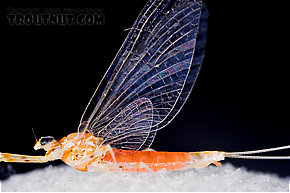 View 9 Pictures
View 9 Pictures
 View 9 Pictures
View 9 PicturesCollected September 19, 2006 from Mystery Creek #43 in New York
Added to Troutnut.com by Troutnut on October 4, 2006
Added to Troutnut.com by Troutnut on October 4, 2006
Heptagenia pulla (Golden Dun) Mayfly Nymph View 5 PicturesI used a microscope to positively identify this nymph as Heptagenia pulla. (Edit six years later: I wish I had explained why I was positive about this. It may have been based on color patterns in an angling text, which are not especially reliable for species ID anymore.)
View 5 PicturesI used a microscope to positively identify this nymph as Heptagenia pulla. (Edit six years later: I wish I had explained why I was positive about this. It may have been based on color patterns in an angling text, which are not especially reliable for species ID anymore.)
 View 5 PicturesI used a microscope to positively identify this nymph as Heptagenia pulla. (Edit six years later: I wish I had explained why I was positive about this. It may have been based on color patterns in an angling text, which are not especially reliable for species ID anymore.)
View 5 PicturesI used a microscope to positively identify this nymph as Heptagenia pulla. (Edit six years later: I wish I had explained why I was positive about this. It may have been based on color patterns in an angling text, which are not especially reliable for species ID anymore.)Collected June 5, 2005 from the Long Lake Branch of the White River in Wisconsin
Added to Troutnut.com by Troutnut on May 25, 2006
Added to Troutnut.com by Troutnut on May 25, 2006
Rhithrogena morrisoni (Western March Brown) Mayfly Nymph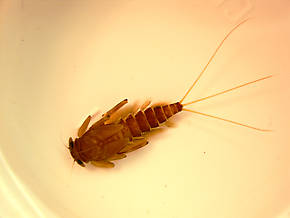 View 4 PicturesSize - (excluding tails) - 12 mm
View 4 PicturesSize - (excluding tails) - 12 mm
Status at time of photo - preserved, but photographed within days of capture.
W. C. Day, Aquatic Insects of California differentiates morrisoni nymphs by submedian pale dots on tergites (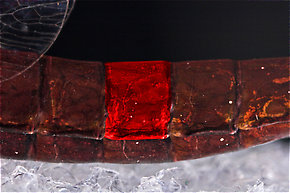 Tergite: The top (dorsal) part of a single segment on an insect's abdomen when it consists of a single chitinous plate (sclerite), or an individual sclerite if the segment has more than one.) 8 & 9, which look to be in evidence. This is one of the "super-hatches" on this river that can be prolific March through April.
Tergite: The top (dorsal) part of a single segment on an insect's abdomen when it consists of a single chitinous plate (sclerite), or an individual sclerite if the segment has more than one.) 8 & 9, which look to be in evidence. This is one of the "super-hatches" on this river that can be prolific March through April.
Entoman
 View 4 PicturesSize - (excluding tails) - 12 mm
View 4 PicturesSize - (excluding tails) - 12 mmStatus at time of photo - preserved, but photographed within days of capture.
W. C. Day, Aquatic Insects of California differentiates morrisoni nymphs by submedian pale dots on tergites (

One tergite of this Isonychia bicolor mayfly spinner is highlighted in red.
Entoman
Collected March 3, 2011 from the Lower Yuba River in California
Added to Troutnut.com by Entoman on November 1, 2011
Added to Troutnut.com by Entoman on November 1, 2011
Female Cinygmula (Dark Red Quills) Mayfly Dun View 6 PicturesThis one was collected in association with a male spinner probably of the same species.
View 6 PicturesThis one was collected in association with a male spinner probably of the same species.
 View 6 PicturesThis one was collected in association with a male spinner probably of the same species.
View 6 PicturesThis one was collected in association with a male spinner probably of the same species.Collected July 1, 2017 from the South Fork Stillaguamish River in Washington
Added to Troutnut.com by Troutnut on July 2, 2017
Added to Troutnut.com by Troutnut on July 2, 2017
Female Leucrocuta hebe (Little Yellow Quill) Mayfly Spinner View 8 Pictures
View 8 Pictures
 View 8 Pictures
View 8 PicturesCollected September 4, 2006 from Willowemoc Creek in New York
Added to Troutnut.com by Troutnut on October 3, 2006
Added to Troutnut.com by Troutnut on October 3, 2006
Female Epeorus frisoni Mayfly Spinner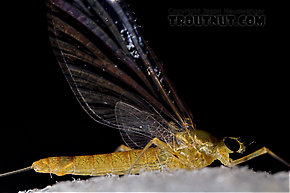 View 8 PicturesI collected this female spinner together with a male dun, a female dun, and another male dun.
View 8 PicturesI collected this female spinner together with a male dun, a female dun, and another male dun.
 View 8 PicturesI collected this female spinner together with a male dun, a female dun, and another male dun.
View 8 PicturesI collected this female spinner together with a male dun, a female dun, and another male dun.Collected September 6, 2006 from Mystery Creek #23 in New York
Added to Troutnut.com by Troutnut on October 3, 2006
Added to Troutnut.com by Troutnut on October 3, 2006
Epeorus pleuralis (Quill Gordon) Mayfly Nymph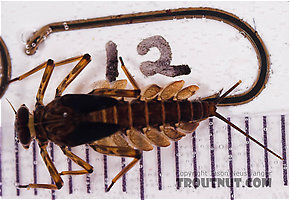 View 4 PicturesThis Epeorus pluralis dun is recently deceased in these photos. I decided not to photograph several lively, less mature nymphs. This one was ready to hatch, as indicated by the black wing pads (
View 4 PicturesThis Epeorus pluralis dun is recently deceased in these photos. I decided not to photograph several lively, less mature nymphs. This one was ready to hatch, as indicated by the black wing pads ( Wing pad: A protrusion from the thorax of an insect nymph which holds the developing wings. Black wing pads usually indicate that the nymph is nearly ready to emerge into an adult.). I believe it had not been dead long enough to lose its natural coloration.
Wing pad: A protrusion from the thorax of an insect nymph which holds the developing wings. Black wing pads usually indicate that the nymph is nearly ready to emerge into an adult.). I believe it had not been dead long enough to lose its natural coloration.
 View 4 PicturesThis Epeorus pluralis dun is recently deceased in these photos. I decided not to photograph several lively, less mature nymphs. This one was ready to hatch, as indicated by the black wing pads (
View 4 PicturesThis Epeorus pluralis dun is recently deceased in these photos. I decided not to photograph several lively, less mature nymphs. This one was ready to hatch, as indicated by the black wing pads (
The wing pads on this final instar Baetidae mayfly nymph are extremely dark.
Collected April 19, 2006 from Mongaup Creek in New York
Added to Troutnut.com by Troutnut on April 21, 2006
Added to Troutnut.com by Troutnut on April 21, 2006
Maccaffertium luteum Mayfly Nymph View 4 Pictures
View 4 Pictures
 View 4 Pictures
View 4 PicturesCollected January 19, 2004 from unknown in Wisconsin
Added to Troutnut.com by Troutnut on January 25, 2006
Added to Troutnut.com by Troutnut on January 25, 2006
Maccaffertium vicarium (March Brown) Mayfly Nymph View 4 PicturesI photographed this Maccaffertium vicarium nymph shortly after it molted to a new instar (Instar: Many invertebrates molt through dozens of progressively larger and better-developed stages as they grow. Each of these stages is known as an instar. Hard-bodied nymphs typically molt through more instars than soft-bodied larvae.) in my holding container. Many nymphs take on drastically different coloration immediately after molting, and this species is no exception.
View 4 PicturesI photographed this Maccaffertium vicarium nymph shortly after it molted to a new instar (Instar: Many invertebrates molt through dozens of progressively larger and better-developed stages as they grow. Each of these stages is known as an instar. Hard-bodied nymphs typically molt through more instars than soft-bodied larvae.) in my holding container. Many nymphs take on drastically different coloration immediately after molting, and this species is no exception.
 View 4 PicturesI photographed this Maccaffertium vicarium nymph shortly after it molted to a new instar (Instar: Many invertebrates molt through dozens of progressively larger and better-developed stages as they grow. Each of these stages is known as an instar. Hard-bodied nymphs typically molt through more instars than soft-bodied larvae.) in my holding container. Many nymphs take on drastically different coloration immediately after molting, and this species is no exception.
View 4 PicturesI photographed this Maccaffertium vicarium nymph shortly after it molted to a new instar (Instar: Many invertebrates molt through dozens of progressively larger and better-developed stages as they grow. Each of these stages is known as an instar. Hard-bodied nymphs typically molt through more instars than soft-bodied larvae.) in my holding container. Many nymphs take on drastically different coloration immediately after molting, and this species is no exception.Collected April 19, 2006 from the Beaverkill River in New York
Added to Troutnut.com by Troutnut on April 21, 2006
Added to Troutnut.com by Troutnut on April 21, 2006
Maccaffertium vicarium (March Brown) Mayfly Nymph View 3 Pictures
View 3 Pictures
 View 3 Pictures
View 3 PicturesCollected January 14, 2004 from unknown in Wisconsin
Added to Troutnut.com by Troutnut on January 25, 2006
Added to Troutnut.com by Troutnut on January 25, 2006
Top 10 Fly Hatches
Top Gift Shop Designs
Eat mayflies.
Top Insect Specimens
Miscellaneous Sites
Troutnut.com is copyright © 2004-2024 Jason
Neuswanger (email Jason). See my FAQ for information about use of my images.
 privacy policy
privacy policy
